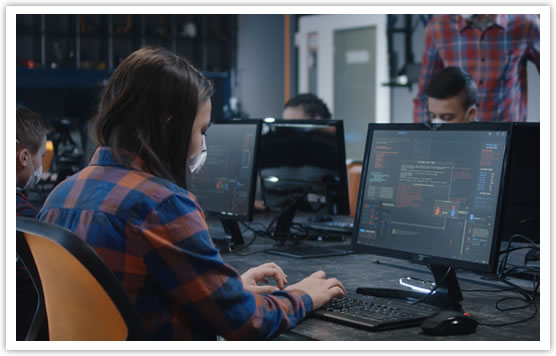PART 1
Training Magazine shared, “86 percent of virtual classroom participants rated the experience just as engaging or more engaging than traditional classroom training. 100 percent of participants were highly satisfied with their training experience.” Is this the only criteria to consider? And, is virtual better than classroom? The answer, it depends. It depends on a lot.
There are textbook recommendations and there are situational and real-world business threats and challenges. Talent development and workplace learning has to be forever conscious, resilient, and nimble to support an organization’s ability to respond to crises. The talent development and/or workplace learning function has to be a role-model for change and transformation. Learning still has to be effective and never more so than during a crisis. Again, is virtual or remote learning better than onsite classroom learning?
While learners may feel satisfied (Level 1*), is this approach having an impact on shifting behavior (Level 3) and are measurable results trending to show an impact (Level 4*)? Being satisfied usually is not enough Research shows a blended approach between both classroom and virtual is ideal in many instances where training is the appropriately diagnosed performance intervention to address a root cause issue.

Training for the mere sake of a training, whether virtual or classroom, has a high level of risk. COVID-19 has raised awareness and inquiry on the value and future of both training delivery approaches in our modern workplace. What is the “new normal” for training and adult learning? Maximizing results and learning impact often drive the delivery method(s) recommended.
Adults learn best when they have a level of personal control of their learning and can move at their own pace, which some virtual delivery methods can offer (i.e. video, eLearning module, etc.). Research also shows greater access body language allows the facilitator to zero in on challenges and provide one-on-one support during a live webinar (over a recorded one or a video) and more so in the live classroom. “Participants are more likely to learn in classes with kinesthetic, multi-sensory, movement-based learning.” (Jordt, Wenderoth 2014) And, the more access we have to hearing words, tone of voice and experiencing body language the greater the short- and long-term learning impacts on business results.
Asynchronous (alone) virtual would be like an eLearning module that is self-paced or video. Synchronous (with others) virtual would be like a live webinar. Classroom (onsite) learning is innately synchronous and can build on the virtual program completed prior. This would allow greater emphasis on levels of experiential learning in the onsite classroom. Virtual learning done prior allows everyone to come into the classroom with a similar baseline of knowledge (Level 2*). This allows the facilitator to pick up from there and maximize the value of the classroom experience and typically less classroom time is required. This means less impact on productivity from less time in the classroom and the ability to perhaps deliver smaller classes with more available time to facilitate.
Virtual learning that includes self-paced eLearning modules delivered asynchronously, will often require content to be stable. If the modularized eLearning curriculum is not stable, updates to the module(s) are likely required and often difficult, time consuming and costly to design and develop. Stable content is suggested for self-paced eLearning modules.
These eLearning modules should be interactive by engaging the participant in some way. Now, short 3- to 5-minute videos can provide an instant “just in time” support level like one might experience in a quick YouTube video. Beyond 3-5 minutes, the less effective it is without engagement.

Adults learn best when information is “chunked” into 3-5-minute segments, as a general rule with an additional minute or 2 for engagement. George Miller, psychologist, introduced the content chunking approach citing short-term memory could only hold seven (plus or minus two) “chunks” of information. (Psychological Review, 1956, 2018) This speaks to our attention span as adults and how our brains work to compartmentalize new information. After each chunked segment, an engagement like a poll question or simulation will help anchor the content for the learner and increase retention as well as application on the job. Failure to engage the learner throughout will lose the learner and likely be perceived as a waste of time by the learner and the investing organization. This is true for both virtual (remote) and classroom (onsite) learning.
A brief virtual approach may be a short-term strategy as a “stop gap” approach to resolve an issue where the classroom is not possible but is the ideal solution based upon a current reality. A long-term classroom follow-up may be recommended when it is possible to address ongoing issues and kinesthetic learning preferences. If nothing else, a cohesive plan for managers to align on the message delivered and hold people accountable after the virtual learning event will support a short-term approach during a crisis scenario.
Having baseline metrics or Key Performance Indicators (KPI’s) clearly identified (Level 4*) prior is essential. Then, monitoring of those KPI metrics will show if a follow-up session is necessary. A follow-up would likely include analysis and direct insights from both low and high performers. Interestingly, high performers are often proactive at tweaking a process to achieve their higher-level result(s).
The duration of a virtual program is recommended to not exceed 90 minutes. If there is content remaining, a 30-60-minute break will allow the person time to rest, manage issues and return focused. The same is true in a classroom learning typically not to exceed 2 hours without a break of at least 10-15 minutes or more depending on the cerebral nature of the content. Breaks allow adult learners to recharge, without them participants risk moving into overwhelm, becoming distracted and listening will break down. There is a point of diminished returns which will have a definite negative impact on desired learning outcomes.
STAY TUNED: PART 2 will go into ROI of both approaches and the impacts COVID is having on virtual and classroom learning.
#virtualclassroom, #classroomlearning, #LevelsofEvaluation, #Virtuallearning, #blendedlearning, #kinestheticlearning, #eLearningmodules, #learningoutcomes, #newnormallearning, #newnormal, #postcovid19training, #remotelearning, #remoteclassroom, #trainingROI, #classroomtraining, #newnormaltraining, #contentchunking, #talentdevelopment, #workplacelearning, #crisis
*NOTE: Level 1-5 refers to Jack Phillip’s 5 Levels of Training Evaluation 1-Reaction, 2-Learning, 3-Behavior, 4-Results, and 5-ROI.



